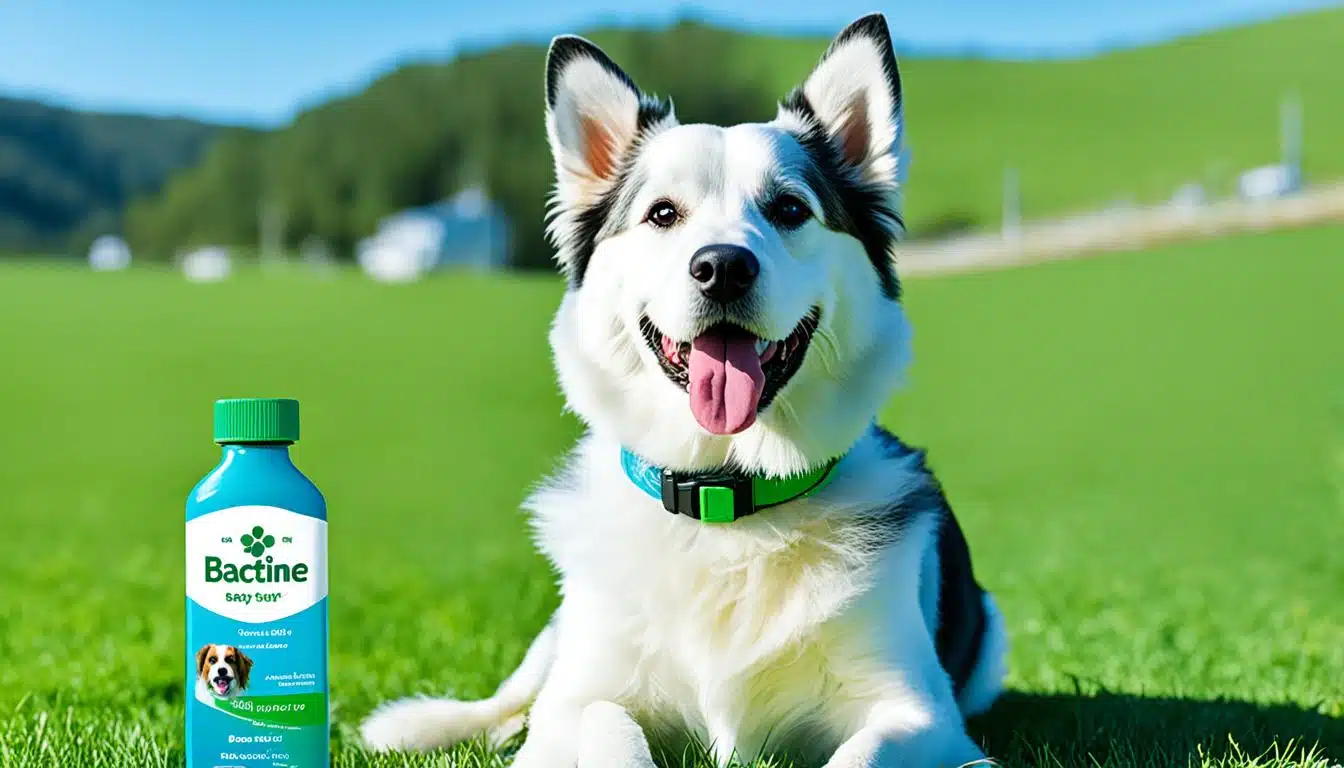When my loyal companion falls victim to a scratch or cut, my first thought always rushes to how I can ease their pain and protect them from infection – just like I would for any family member. But is reaching for a staple in our human first-aid kits, like Bactine, a safe bet for dogs? The question lingers in the mind of any caring pet owner: Is Bactine safe for dogs? I’ve heard the debates and concerns regarding Bactine dog wound care, and it has made me ponder over the safety and efficacy of applying a Bactine antiseptic for pets. Could this well-known Bactine topical solution for dogs be the answer, or are we opening the door to unseen complications?
As a pet owner, I am continually seeking the best for my furry friend’s health and well-being. Therefore, I dove deep into veterinary wisdom to untangle this conundrum. If you’re like me and find yourself hovering in the pet aisle, questioning every label and ingredient, you’ll want to stick around as we explore this topical question together.
Key Takeaways
- Understanding the potential uses and risks of Bactine antiseptic for pets.
- Identifying the active ingredients in Bactine that might impact canine health.
- Exploring the necessity of veterinary consultation before using Bactine for dogs.
- Weighing the benefits against the possible side effects when considering Bactine dog wound care.
- Gauging the safety profile of Bactine topical solution for dogs based on professional advice.
Understanding Bactine and Its Common Uses
When considering what products to use on our furry friends, it’s essential to understand what they contain and how they’re typically used. Many pet owners find themselves wondering, “Can I use Bactine on my dog?” Let’s dive into what Bactine actually is, the active ingredients it contains, and the common ways it is incorporated into human healthcare, which might shed some light on using Bactine on dogs.
What is Bactine?
Bactine is a well-known topical antiseptic that’s been a staple in medicine cabinets for decades. It’s a product marketed for its ability to prevent infection in minor cuts, scrapes, and burns. Many might consider using Bactine for dogs, given its widespread availability and proven efficacy in humans. However, the decision to use it on pets should be informed by a thorough understanding of the product.
Bactine’s Active Ingredients
At the heart of Bactine’s antiseptic power are two active ingredients: lidocaine and benzalkonium chloride. Lidocaine acts as a local anesthetic, providing pain relief upon application. Benzalkonium chloride serves as the antiseptic component, helping to ward off infection by killing bacteria. This combination might make one think that using Bactine on dogs is a good idea, especially when dealing with painful cuts or abrasions.
Typical Uses of Bactine in Human Healthcare
In human healthcare, Bactine is applied to minor injuries as a first-aid measure to clean the wound and soothe pain. Its effectiveness in preventing bacterial infections in cuts, scrapes, and burns in humans leads some dog owners to ponder, “Bactine for dogs—could it provide the same protection?” This question is particularly relevant when pet owners require an immediate and accessible remedy for their dog’s minor wounds.
As a responsible pet owner, it’s my role to not only ask, “Can I use Bactine on my dog?” but also to seek out reliable information to ensure the well-being of my canine companion. Awareness of Bactine’s primary uses and ingredients allows for a more meaningful conversation with a veterinarian regarding appropriate wound care for dogs. The next sections will delve deeper into the specifics of Bactine’s safety and alternative care methods to consider for our pets.
Is Bactine Safe for Dogs?

As a pet owner, the health and well-being of my furry friend are paramount. So when it comes to treating their wounds, naturally, I want to use something trusted and, most importantly, safe. Today, one of the pressing questions I tackle is: Is Bactine safe for dogs? Given Bactine’s popularity in human first aid kits, it’s not uncommon for dog owners to wonder if this antiseptic is suitable for their canine companions as well.
The short answer requires a bit more nuance. Bactine and dogs’ safety is a topic that involves understanding the ingredients present in the product and how they interact with canine biology. Bactine’s active ingredient, lidocaine, is known for its pain-relieving properties, but it’s the safety margin for use in dogs that necessitates our scrutiny. To offer an insightful perspective, I consulted a variety of veterinary sources to discuss the suitability and potential risks of employing Bactine for treating canine wounds.
- Pros: Bactine provides a sting-free application and can ease the discomfort of minor cuts and bruises.
- Cons: Some ingredients may be toxic if ingested in large amounts or if used on extensive areas of the body.
In evaluating the risks versus benefits, it’s clear that pet owners should proceed with caution. While Bactine might offer immediate relief for minor injuries, its formula is not designed with dogs in mind, and there may be better-suited alternatives available that cater specifically to canine health needs. Below is a quick glance at some essential considerations when it comes to using Bactine on dogs:
| CONSIDERATIONS FOR BACTINE USE | ADVICE FROM VETERINARY SOURCES |
|---|---|
| Amount of Bactine Applied | Use sparingly; a small dab on a minor wound. |
| Area of Application | Avoid areas where dogs can easily lick the product. |
| Alternative Options | Consult a vet for canine-specific treatments. |
In conclusion, the question of Is Bactine safe for dogs isn’t a matter of a simple yes or no—it’s an invitation for us to be more vigilant and informed as dog owners. For any wounds beyond the most minor scrapes, consulting your vet should always be the first step. Remember, our canine friends rely on us to make the best choices for their health and happiness.
The Advantages of Using Bactine on Canine Wounds
As an experienced pet owner, I’ve seen my fair share of minor injuries and itches on my furry companions. It’s no wonder that I’m constantly searching for products that can provide relief and promote healing. This is how I discovered Bactine spray for dogs, a product known for its utility in human first aid kits that has potential benefits for our canine friends too. Let’s dig into the advantages of using Bactine on dogs for wound care.
Pain Relief Properties
Dealing with an injured dog can be challenging, as pain is often the first hurdle in the healing process. Bactine’s pain-relieving properties come from its local anesthetic component—typically lidocaine. This can temporally numb the area, providing significant comfort for dogs with minor wounds. For any pet parent, seeing their dog in less pain is a major relief, and Bactine wound treatment for dogs might just be the answer.
Antibacterial Benefits
A secondary, yet equally important advantage is Bactine’s antibacterial action. Infections can delay healing and cause significant complications. Fortunately, the active ingredients in Bactine are known to reduce bacterial contamination in minor cuts and scrapes. This antibacterial quality not only helps to ward off infection but also assists in creating an optimal environment for wound healing.
Promoting Faster Healing
Any treatment that speeds up the recovery process is a boon, and Bactine is no exception. By mitigating pain and reducing the risk of infection, it stands to reason that Bactine could promote faster healing in some cases. However, while considering the inclusion of Bactine spray for dogs in your pet’s first aid kit, it’s always recommended to consult with your veterinarian to ensure it’s the right choice for your dog’s specific needs.
| ATTRIBUTE | BENEFIT |
|---|---|
| Local Anesthetic | Provides pain relief for dogs |
| Antibacterial Action | Decreases risk of infection on wounds |
| Convenient Application | Easy to use spray form for quick application |
To wrap up my thoughts on Bactine wound treatment for dogs, it’s clear that when used properly, it offers several benefits that can ease your dog’s discomfort and support a swift recovery. Always keep in touch with your vet to stay informed on the best care methods for your pooch!
Risks and Precautions When Using Bactine on Dogs

As a devoted pet owner, my primary concern is always the safety and well-being of my furry friends. When it comes to treating their minor wounds, I carefully consider all options to ensure I don’t inadvertently cause harm. In light of this, it’s important to discuss the potential risks and necessary precautions when considering the use of Bactine for Bactine dog wound care.
Potential Toxicity Concerns
Though Bactine is commonly found in many human first-aid kits, its suitability for dogs is subject to scrutiny due to potential toxicity concerns. The active ingredients in Bactine, such as lidocaine, can cause adverse reactions if not used appropriately. Dogs have a markedly different metabolism from humans, and accidental ingestion or overuse on their wounds can lead to toxicity. Therefore, it’s crucial to understand that Bactine and dogs safety is not always congruent, and professional guidance is recommended.
When to Avoid Bactine on Your Dog
There are specific scenarios where Bactine should be completely avoided to prevent any chance of a negative reaction. For instance, Bactine should not be used on open or deep wounds, in or around the eyes, or on areas of the body where the dog can easily lick it off. Particularly, avoid Bactine for dogs who are prone to allergies or have sensitive skin, and always consult with your veterinarian before applying any human medication to your pet’s injuries.
Signs of a Negative Reaction
Being observant of how your dog responds after applying Bactine can save them from potential distress. Signs of a negative reaction can include excessive licking at the application site, signs of discomfort, redness, or swelling, and in severe cases, symptoms such as vomiting or lethargy. Immediate veterinary attention is imperative if you notice any of these symptoms as they could be indicative of a more serious issue. The fine balance of Bactine and dogs safety rests on our shoulders as owners; thus, awareness and prompt action are key.
Alternative Wound Care Options for Dogs
While Bactine can be a good option for treating minor wounds on dogs, it’s important to explore a variety of care techniques to ensure the best possible outcome for our furry friends. Whether you’re looking for more natural solutions or products specifically formulated for pets, there’s a range of options that can be both safe and effective. Let’s delve into some alternatives that you can consider for your dog’s wound care.
Natural Antiseptics for Dogs
When it comes to treating your dog’s wounds, natural antiseptics can be incredibly beneficial. These are substances derived from plants that have antimicrobial properties, which means they can prevent the growth of bacteria and help fend off infections. Some commonly used natural antiseptics for dogs include manuka honey, aloe vera, and tea tree oil. However, it’s crucial to use these products correctly and in moderation, as some natural remedies can be potent and could potentially cause irritation if not diluted properly.
Veterinary-Recommended Products
Cleaning and protecting your pet’s wounds is essential for their recovery, and using veterinary-recommended products can make all the difference. Vets often suggest specific brands that have been clinically tested and proven to be safe and effective for dogs. Products such as Vetericyn Wound & Skin Care and Banixx Pet Care are well-regarded options that have garnered praise from veterinarians for their ability to aid in healing without stinging or causing discomfort to pets.
Homemade Remedies for Minor Wounds
For dog owners who prefer preparing treatments at home, there are safe and simple homemade remedies that can be used for minor wounds. A saline solution, for example, can be easily made by dissolving a teaspoon of salt in a cup of warm water, and it’s excellent for cleaning out wounds. Herbal compresses using herbs like chamomile or calendula can also help in reducing inflammation and promoting healing. As with any treatment, it’s essential to research and consult with your veterinarian to ensure the remedy is appropriate for your dog’s specific situation.
Conclusion
As we wrap up our exploration into the safety of Bactine as an antiseptic for pets, particularly focusing on whether Is Bactine safe for dogs, it’s clear that the decision to use this topical solution requires careful consideration. Throughout this article, we’ve sifted through the intricacies of Bactine’s ingredients, its potential for pain relief, and its antibacterial properties. But as a pet owner, your top priority is always the welfare of your furry friend.
Summarizing Bactine’s Safety for Dogs
The verdict on Bactine isn’t black and white. While it might offer certain benefits as a Bactine topical solution for dogs, it has risks. The concerns of toxicity and the appropriate response to adverse reactions remind us that Bactine was primarily formulated for humans, not canines. This underscores the importance of considering all aspects of a product before deeming it suitable for our pets.
Key Takeaways for Pet Owners
What should you, as a pet owner, take away from this discussion? Whether you’re looking at Bactine or any other Bactine antiseptic for pets, it’s critical to weigh the pros and cons. Understand the ingredients, be alert to signs of distress in your pet post-application, and always have a plan for quick intervention should a negative reaction occur.
When to Consult a Veterinarian
My final note is a reminder that the guidance of a veterinarian is indispensable. Professional advice is paramount when it comes to health decisions for your dog, even for something as seemingly simple as a wound treatment. If you’re ever in doubt about using products like Bactine on your dog, I urge you to consult your vet. They can provide tailored advice that ensures the safety and well-being of your beloved companion.
FAQ
What is Bactine?
Bactine is a topical antiseptic solution used in human healthcare to treat minor cuts, scrapes, and burns. It is known for its pain-relieving and antibacterial properties, making it a popular over-the-counter choice for first aid.
What are the active ingredients in Bactine?
The active ingredients in Bactine include lidocaine, which acts as a pain reliever, and benzalkonium chloride, which serves as an antibacterial agent to help prevent infection in minor wounds.
Can I use Bactine on my dog?
Using Bactine on dogs is not recommended without consulting a veterinarian first. While Bactine is formulated for humans, the active ingredients may not be safe for dogs or could cause adverse reactions, depending on the individual animal’s health and circumstances.
Is Bactine safe for dogs?
The safety of Bactine for dogs is not assured, as it is designed for human use. Some dogs may have sensitivities or allergies to the ingredients in Bactine. It’s essential to seek veterinary advice before applying Bactine or human medicine to a dog’s wound.
What pain relief properties does Bactine have that could benefit dogs?
Bactine contains lidocaine, relieving pain by numbing the area it is applied to. If deemed safe by a veterinarian, this property could help manage pain in dogs with minor wounds. However, the safety and appropriate dosage must be confirmed by a professional.
Are there antibacterial benefits of using Bactine on dogs?
Bactine’s antibacterial component, benzalkonium chloride, can help prevent infection by killing bacteria. If a vet approves Bactine’s use, it may offer antibacterial benefits for treating a dog’s minor wounds.
How can Bactine promote faster healing in dogs?
Bactine could create a more conducive environment for wound healing by reducing pain and preventing infection. However, the product’s safety and efficacy for dogs need to be determined by a veterinarian.
What are potential toxicity concerns with Bactine for dogs?
The lidocaine in Bactine can be toxic to dogs if ingested in significant amounts or if used excessively on the skin. Benzalkonium chloride can also be irritating or toxic if not used correctly. Always consult a vet to avoid these risks.
When should I avoid using Bactine on my dog?
Avoid using Bactine on large wounds, deep cuts, bites, or burns without veterinary approval. Also, refrain from using it on dogs with allergies to lidocaine or benzalkonium chloride and on pets that may lick the treated area extensively.
What are the signs of an adverse reaction to Bactine in dogs?
Signs of an adverse reaction can include excessive licking of the treated area, skin irritation or rash, difficulty breathing, or more severe symptoms like weakness or collapse. If any adverse reactions are observed, contact your veterinarian immediately.
What are some natural antiseptics safe for dogs?
Natural antiseptics that are generally safe for dogs include diluted chlorhexidine solution, honey, and certain essential oils diluted with carrier oil. Always check with your vet before using any new substance to treat your dog’s wounds.
What are some veterinary-recommended products for wound care in dogs?
Vets often recommend pet-specific wound cleansers and healing ointments formulated for dogs’ skin and biology. These can include products like Vetericyn or pet-formulated chlorhexidine solutions.
Can I use homemade remedies for minor wounds on my dog?
Yes, with caution and veterinary guidance, simple homemade remedies like saline solution (salt water) or dilute apple cider vinegar can be used for cleaning minor wounds. However, it’s best to consult your vet for recommendations tailored to your dog’s needs.





